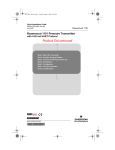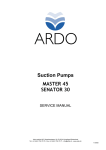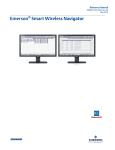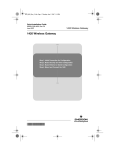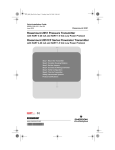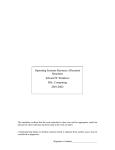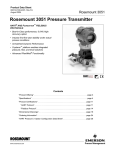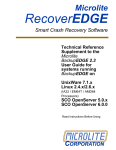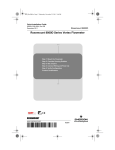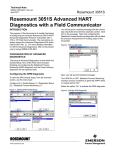Download www.rosemount.com - Industry Surplus Australia
Transcript
4593 Rev AB.fm Page 1 Thursday, September 21, 2006 3:12 PM Quick Installation Guide 00825-0100-4593, Rev AB September 2006 Rosemount 1151 Rosemount 1151 Smart Pressure Transmitter Start Step 1: Mount the Transmitter Step 2: Consider Housing Rotation Step 3: Connect the Wiring and Power Up Step 4: Set Switches Step 5: Configuration Step 6: Trim the Transmitter Product Certifications End © 2006 Rosemount Inc. All rights reserved. All marks property of owner. Rosemount and the Rosemount logotype are registered trademarks of Rosemount Inc. HART® ¢00825-0100-4593X¤ www.rosemount.com 4593 Rev AB.fm Page 2 Thursday, September 21, 2006 3:12 PM Quick Installation Guide 00825-0100-4593, Rev AB September 2006 Rosemount 1151 Emerson Process Management Rosemount Division Emerson Process Management GmbH & Co. OHG 8200 Market Boulevard Chanhassen, MN USA 55317 T (US) (800) 999-9307 T (Intnl) (952) 906-8888 F (952) 949-7001 Shipping Address: Argelsrieder Feld 3 82234 Wessling Germany T 49 (8153) 9390 F49 (8153) 939172 Emerson Process Management Asia Pacific Private Limited Beijing Rosemount Far East Instrument Co., Limited 1 Pandan Crescent Singapore 128461 T (65) 6777 8211 F (65) 6777 0947/65 6777 0743 No. 6 North Street, Hepingli, Dong Cheng District Beijing 100013, China T (86) (10) 6428 2233 F (86) (10) 6422 8586 IMPORTANT NOTICE This installation guide provides basic guidelines for Rosemount 1151 transmitters. It does not provide instructions for configuration, diagnostics, maintenance, service, troubleshooting, Explosion-Proof, Flame-Proof, or intrinsically safe (I.S.) installations. Refer to the Rosemount 1151 reference manual (document number 00809-0100-4593) for more instruction. This manual is also available electronically on www.rosemount.com. WARNING Explosions could result in death or serious injury: Installation of this transmitter in an explosive environment must be in accordance with the appropriate local, national, and international standards, codes, and practices. Please review the approvals section of the 1151 reference manual for any restrictions associated with a safe installation. • Before connecting a HART-based communicator in an explosive atmosphere, make sure the instruments in the loop are installed in accordance with intrinsically safe or non-incendive field wiring practices. • In an Explosion-Proof/Flame-Proof installation, do not remove the transmitter covers when power is applied to the unit. Process leaks may cause harm or result in death. • To avoid process leaks, only use the o-ring designed to seal with the corresponding flange adapter. Electrical shock can result in death or serious injury. • Avoid contact with the leads and the terminals. High voltage that may be present on leads can cause electrical shock. 4593 Rev AB.fm Page 3 Thursday, September 21, 2006 3:12 PM Quick Installation Guide 00825-0100-4593, Rev AB September 2006 Rosemount 1151 STEP 1: MOUNT THE TRANSMITTER Liquid Flow Applications 1. Place taps to the side of the line. 2. Mount beside or below the taps. Flow Gas Flow Applications 1. Place taps in the top or side of the line. 2. Mount beside or above the taps. Flow Steam Flow Applications 1. Place taps to the side of the line. 2. Mount beside or below the taps. 3. Fill impulse lines with water. Flow 4593 Rev AB.fm Page 4 Thursday, September 21, 2006 3:12 PM Quick Installation Guide 00825-0100-4593, Rev AB September 2006 Rosemount 1151 STEP 1 CONTINUED... Pipe Mount Panel Mount(1) Flat Mount (1) Panel bolts are customer supplied. 4593 Rev AB.fm Page 5 Thursday, September 21, 2006 3:12 PM Quick Installation Guide 00825-0100-4593, Rev AB September 2006 Rosemount 1151 STEP 2: CONSIDER HOUSING ROTATION To improve field access or to better view the optional LCD display: 1. Loosen the housing lock nut. 2. Rotate the housing clockwise to the desired position – up to 90° from its original position. Over rotating will damage the transmitter. 3. If the desired position is attained, tighten the housing lock nut. 4. If the desired position cannot be reached because the housing will not rotate further, rotate the housing counterclockwise until in the desired position (up to 90° from its original position). 5. Tighten the housing lock nut to 420-in/lb. Use a sealing compound (Loctite 222 – Small Screw Threadlocker) on the threads to ensure a watertight seal on the housing. NOTE If the desired position cannot be attained within the 90° limit, the transmitter will need to be disassembled. See the Rosemount 1151 reference manual (document number 00809-0100-4593) for further instruction. Housing Lock Nut 4593 Rev AB.fm Page 6 Thursday, September 21, 2006 3:12 PM Quick Installation Guide 00825-0100-4593, Rev AB September 2006 Rosemount 1151 STEP 3: CONNECT WIRING AND POWER UP Use the following steps to wire the transmitter: 1. Remove the housing cover on the side marked TERMINALS on the nameplate. 2. Connect the positive lead to the “+” terminal and the negative lead to the “–” terminal. NOTE Do not connect the powered signal wiring to the test terminals. Power could damage the test diode in the test connection. Twisted pair cable should be used for best results. In high EMI/RFI environments, use either transient terminal block or shielded signal wiring. Use 12 to 24 AWG wire and do not exceed 5,000 feet (1500 meters). 3. Plug and seal unused conduit connections. 4. If applicable, install wiring with a drip loop. Arrange the drip loop so the bottom is lower than the conduit connections and the transmitter housing. Figure 1 shows wiring connections necessary to power a 1151 and enable communications with a hand-held HART communicator. A HART Interface may be connected at any termination point in the loop. signal loop must have 250 ohms minimum load for communications. Signal loop may be grounded at any point or left ungrounded 4593 Rev AB.fm Page 7 Thursday, September 21, 2006 3:12 PM Quick Installation Guide 00825-0100-4593, Rev AB September 2006 Rosemount 1151 Figure 1. Field Wiring Diagram Power Supply Current Meter Optional Indicator RL ≥ 250 ⍀ 4593 Rev AB.fm Page 8 Thursday, September 21, 2006 3:12 PM Quick Installation Guide 00825-0100-4593, Rev AB September 2006 Rosemount 1151 STEP 3 CONTINUED... Power Supply The dc power supply should provide power with less than two percent ripple. The total resistance load is the sum of the resistance of the signal leads and the load resistance of the controller, indicator, and related pieces. Note that the resistance of intrinsic safety barriers, if used, must be included. Figure 2. Load Limitation Rmax RL Operating Region Rmin Vmin Code S(1) Vmin 12 Vmax 45 Rmin 0 VS Rmax 1650 Vmax RL at Supply Voltage (VS) RL = 43.5 (VS – 12) (1) A minimum of 250 Ω is required for communication. 4593 Rev AB.fm Page 9 Thursday, September 21, 2006 3:12 PM Quick Installation Guide 00825-0100-4593, Rev AB September 2006 Rosemount 1151 STEP 4: SET THE SWITCHES Failure Mode Alarm Switch 1. Remove the housing cover. 2. Locate the failure mode switch (see Figure 3). 3. Move the switch to the desired alarm setting. To set the failure mode to high alarm, position the switch toward “HI.” To set the failure mode to low alarm, position the switch to “LO.” 4. Replace the housing cover. Write-Protect Switch In the “ON” position, the write-protect switch prevents changes to the configuration data. 1. Remove the housing cover. 2. Move the write-protect switch to the “OFF.” 3. Verify transmitter configuration (see “Verify Transmitter Configuration”). 4. Move the write-protect switch to the “ON.” 5. Replace the housing cover. Figure 3. Switch Locations Write-Protection Switch Failure Mode Switch HI Zero Adjustment Buttons 4593 Rev AB.fm Page 10 Thursday, September 21, 2006 3:12 PM Quick Installation Guide 00825-0100-4593, Rev AB September 2006 Rosemount 1151 STEP 5: VERIFY CONFIGURATION Verify Transmitter Configuration NOTE: A check (3) indicates the basic configuration parameters. At minimum, these parameters should be verified as part of the configuration and startup procedure. Table 1. HART Communicator Fast Key Sequence Function Fast Key Sequences Analog Output 3 Analog Output Alarm 1, 4, 3, 3 Burst Mode Control 1, 4, 3, 4, 3 Burst Operation 1, 4, 3, 4, 4 Calibration 1, 2, 3 Characterize 1, 4, 1, 1, 2, 2 ✓ Damping 1, 3, 6 Date 1, 3, 4, 1 Descriptor 1, 3, 4, 2 Digital-to-Analog Trim (4–20 mA Output) 1, 2, 3, 2, 1 Field Device Information 1, 4, 4, 1 Full Trim 1, 2, 3, 3 Keypad Input 1, 2, 3, 1, 1 Loop Test 1, 2, 2 Lower Range Value 4, 1 Lower Sensor Trim 1, 2, 3, 3, 2 Message 1, 3, 4, 3 Meter Type 1, 3, 4, 5 Number of Requested Preambles 1, 4, 3, 4, 2 Percent Range 1, 1, 2 Poll Address 1, 4, 3, 4, 1 Pressure 2 ✓ Range Values 1, 3, 3 Rerange 1, 2, 3, 1 Scaled D/A Trim (4–20 mA Output) 1, 2, 3, 2, 2 Self-Test (Transmitter) 1, 2, 1, 1 Sensor Information 1, 4, 4, 2 4593 Rev AB.fm Page 11 Thursday, September 21, 2006 3:12 PM Quick Installation Guide 00825-0100-4593, Rev AB September 2006 Sensor Trim Points Status ✓ Tag ✓ Transfer Function (Setting Output Type) Transmitter Security (Write Protect) Trim Analog Output ✓ Units (Process Variable) Upper Range Value Upper Sensor Trim Zero Trim Rosemount 1151 1, 2, 3, 3, 4 1, 2, 1, 2 1, 3, 1 1, 3, 5 1, 3, 4, 4 1, 2, 3, 2 1, 3, 2 5, 2 1, 2, 3, 3, 3 1, 2, 3, 3, 1 Configure LCD Display Figure 4. LCD Meter. Digital Bar Graph Left Configuration Button Retaining Ring Right Configuration Button NOTE The LCD display time-out is approximately 16 seconds. If keys are not pressed within this period, the indicator reverts to reading the signal. 4593 Rev AB.fm Page 12 Thursday, September 21, 2006 3:12 PM Quick Installation Guide 00825-0100-4593, Rev AB September 2006 Rosemount 1151 STEP 5 CONTINUED... Position the Decimal Point and Select the Meter Function 1. Unscrew the retaining ring shown in Figure 4 and remove the LCD display cover. 2. Press the left and right configuration buttons simultaneously and release immediately. 3. To move the decimal point to the desired location, press the left configuration button. Note that the decimal point wraps around. 4. To scroll through the mode options, press the right configuration button until the desired mode is displayed (see Table 2). 5. Press both configuration buttons simultaneously for two seconds. 6. Replace the LCD Display cover. Table 2. LCD Display Modes Options Relationship between Input Signal and Digital Display L in Linear L in F Linear with five-second filter Srt Square root SrtF Square root with five-second filter Square root function: relates to the digital display. The bar graph output remains linear with the current signal. Square root response: digital display will be proportional to the square root of the input current where 4 mA=0 and 20 mA=1.0, scaled per the calibration procedure. The transition point from linear to square root is at 25% of full scale flow. Filter response: operates upon “present input” and “input received in the previous five second interval” in the following manner: Display = (0.75 x previous input) + (0.25 x present input) This relationship is maintained provided that the previous reading minus the present reading is less than 25% of full scale. NOTE The meter displays “----” for approximately 7.5 seconds while the information is being stored. 4593 Rev AB.fm Page 13 Thursday, September 21, 2006 3:12 PM Quick Installation Guide 00825-0100-4593, Rev AB September 2006 Rosemount 1151 STEP 5 CONTINUED... Set the Display Equivalent to a 4 mA Signal 1. Unscrew the retaining ring shown in Figure 4 and remove the LCD display cover. 2. Press the left button for two seconds. 3. To decrement the display numbers, press the left configuration button and to increment the numbers, press the right configuration button. Set the numbers between –999 and 1000. 4. To store the information, press both configuration buttons simultaneously for two seconds. 5. Replace the LCD display cover. Set the Display Equivalent to a 20 mA Signal 1. Unscrew the retaining ring shown in Figure 4 and remove the LCD display cover. 2. Press the right button for two seconds. 3. To decrement the display numbers, press the left configuration button on the display and to increment the numbers, press the right configuration button. Set the numbers between –999 and 9999. The sum of the 4 mA point and the span must not exceed 9999. 4. To store the information, press both configuration buttons simultaneously for two seconds. The LCD display is now configured. 5. Replace the LCD Display cover. 4593 Rev AB.fm Page 14 Thursday, September 21, 2006 3:12 PM Quick Installation Guide 00825-0100-4593, Rev AB September 2006 Rosemount 1151 STEP 6: TRIM THE TRANSMITTER NOTE Transmitters are shipped fully calibrated per request or by the factory default of full scale (span = upper range limit). Full Trim A full trim is a two-point sensor calibration where two end-point pressures are applied, and the transmitter process variable output is adjusted to agree with the pressure input. Using the HART Communicator HART Fast Keys 1, 2, 3, 3 Steps 1. Equalize or vent the transmitter and connect HART communicator. 2. At the menu, input the HART Fast Key sequence. 3. Follow the commands to perform a full trim. Zero Trim A zero trim is a single-point adjustment used for compensating mounting position effects. When performing a zero trim, ensure that the equalizing valve is open and all wet legs are filled to the correct level. If zero offset is less than 3% of true zero, follow the “Using the HART Communicator” instructions below. If zero offset is greater than 3% of true zero, follow the “Using the Transmitter Zero Adjustment Buttons” instructions. Using the HART Communicator HART Fast Keys 1, 2, 3, 3, 1 Steps 1. Equalize or vent the transmitter and connect HART communicator. 2. At the menu, input the HART Fast Key sequence. 3. Follow the commands to perform a zero trim. 4593 Rev AB.fm Page 15 Friday, September 22, 2006 9:16 AM Quick Installation Guide 00825-0100-4593, Rev AB September 2006 Rosemount 1151 STEP 6 CONTINUED... Using the Transmitter Zero Adjustment Buttons Perform the following steps to perform a rerange using the zero adjustment buttons (see Figure 3). 1. Apply a pressure equivalent to the lower calibrated value on the high side of the transmitter. 2. Remove the circuit side cover to expose the span and zero buttons. Hold both the span and zero buttons down simultaneously for at least five seconds to activate the controls. 3. Press the zero button for five seconds to set the 4 mA point. Verify that the output is 4 mA. 4. Apply a pressure equivalent to the higher calibrated value to the high side of the transmitter. 5. Press the span button for five seconds to set the 20 mA point. Verify that the output is 20 mA. 4-20 mA Output Trim A 4-20 mA output trim adjusts the transmitter milliampere output to match plant standards. This procedure is used to trim the transmitter using a current meter. Using the HART Communicator HART Fast Keys 1, 2, 3, 2, 2 Steps 1. Equalize or vent the transmitter and connect HART communicator. 2. At the menu, input the HART Fast Key sequence. 3. Follow the commands to perform a full trim. 4593 Rev AB.fm Page 16 Thursday, September 21, 2006 3:12 PM Quick Installation Guide 00825-0100-4593, Rev AB September 2006 Rosemount 1151 PRODUCT CERTIFICATIONS Approved Manufacturing Locations Rosemount Inc. — Chanhassen, Minnesota, USA Fisher-Rosemount GmbH & Co. — Wessling, Germany Emerson Process Management Asia Pacific Private Limited — Singapore Beijing Rosemount Far East Instrument Co., Limited – Beijing, China European Directive Information The EC declaration of conformity for all applicable European directives for this product can be found on the Rosemount website at www.rosemount.com. A hard copy may be obtained by contacting our local sales office. ATEX Directive (94/9/EC) Emerson Process Management complies with the ATEX Directive. European Pressure Equipment Directive (PED) (97/23/EC) 1151GP9, 0; 1151HP4, 5, 6, 7, 8 Pressure Transmitters — QS Certificate of Assessment - EC No. PED-H-20 Module H Conformity Assessment All other 1151 Pressure Transmitters — Sound Engineering Practice Transmitter Attachments: Diaphragm Seal - Process Flange - Manifold — Sound Engineering Practice Electro Magnetic Compatibility (EMC) (89/336/EEC) All models — EN 50081-1: 1992; EN 50082-2:1995; EN 61326-1:1997 – Industrial 4593 Rev AB.fm Page 17 Thursday, September 21, 2006 3:12 PM Quick Installation Guide 00825-0100-4593, Rev AB September 2006 Rosemount 1151 Hazardous Locations Certifications North American Certifications Factory Mutual (FM) Approvals FM Explosion Proof tag is standard. Appropriate tag will be substituted if optional certification is selected. I5 Explosion Proof: Class I, Division 1, Groups B, C, and D. Dust-Ignition Proof: Class II, Division 1, Groups E, F, and G; Class III, Division 1. Indoor and outdoor use. NEMA 4X. Factory Sealed. Intrinsically safe for Class I, II, and III Division 1, Groups A, B, C, D, E, F, and G hazardous locations in accordance with entity requirements and Control drawing 01151-0214 and 00268-0031. Non- incendive for Class I, Division 2, Groups A, B, C and D hazardous locations. For entity parameters see control drawing 01151-0214. Canadian Standards Association (CSA) Approvals E6 Explosion proof for Class I, Division 1, Groups C and D; Class II, Division 1, Groups E, F, and G; Class III, Division 1 Hazardous Locations. Suitable for Class I, Division 2, Groups A, B, C, and D; CSA enclosure type 4X. Factory Sealed. I6 Intrinsically safe for Class I, Division 1, Groups A, B, C, and D hazardous locations when connected per Drawing 01151-2575. For entity parameters see control drawing 01151-2575. Temperature Code T2D. 4593 Rev AB.fm Page 18 Thursday, September 21, 2006 3:12 PM Quick Installation Guide 00825-0100-4593, Rev AB September 2006 Rosemount 1151 European Certifications E8 ATEX Flameproof Certification Number CESI03ATEX037 ATEX Marking II 1/2 G EEx d IIC T6 (–40 ≤ Ta ≤ 40 °C) EEx d IIC T4 (–40 ≤ Ta ≤ 80 °C) 1180 V = 60 Vdc maximum ATEX Intrinsic Safety Certification I1 Certification Number BAS99ATEX1294X ATEX Marking II 1 GD EEx ia IIC T5 (–60 ≤ Ta ≤ 40 °C) EEx ia IIC T4 (–60 ≤ Ta ≤ 80 °C) Dust Rating: T90 °C (Ta = –20 to 40 °C) IP66 1180 Entity Parameters Ui = 30V Ii = 125 mA Pi = 1.0 W (T4) or 0.67 W (T5) Ci = 0.034 µF Li = 20 µH Special Conditions for safe use (x): The apparatus is not capable of withstanding the 500V insulation test required by EN50020:1994. This must be taken into account when installing the apparatus. 4593 Rev AB.fm Page 19 Thursday, September 21, 2006 3:12 PM Quick Installation Guide 00825-0100-4593, Rev AB September 2006 Rosemount 1151 ATEX Type N and Dust Certification N1 Certificate Number: BAS99ATEX3293X ATEX Marking: II 3 GD EEx nL IIC T5 (-40 ≤ Ta ≤ 40 °C) EEX nL IIC T4 (-40 ≤ Ta ≤ 80 °C) Dust Rating: T90 °C (Ta = -20 to 40 °C) Ui = 45 Vdc maximum IP66 Special Conditions for safe use (x): The apparatus is not capable of withstanding the 500V insulation test required by EN 50021:1999. This must be taken into account when installing the apparatus. Australian Certifications Standards Association of Australia (SAA) Certification E7 Flameproof Certificate Number Ex 494X Ex d IIB + H2 T6 DIP T6 IP65 Special Conditions for safe use (x): For transmitters having NPT, PG or G cable entry threads, an appropriate flameproof thread adaptor shall be used to facilitate application of certified flameproof cable glands or conduit system. 4593 Rev AB.fm Page 20 Thursday, September 21, 2006 3:12 PM Quick Installation Guide 00825-0100-4593, Rev AB September 2006 I7 Rosemount 1151 Intrinsically Safe Certificate Number: Ex 122X Ex ia IIC T5 (Tamb = 40 °C) Ex ia IIC T4 (Tamb = 80 °C) Special Conditions for Safe Use (x): The equipment has been assessed to the entity concept and accordingly the following electrical parameters must be taken into account during installation. Table 3. Entity Parameters Ui = 30V Ii = 125 mA Pi = 1.0 W (T4) or 0.67W (T5) Ci = 14.8 nF Li = 20 µH N7 Type N Certificate Number: Ex 887X Ex n IIC T6 (Tamb = 40 °C) Ex n IIC T5 (Tamb = 80 °C) Special Conditions for safe use (x): The equipment must be connected to a supply voltage which does not exceed the rated voltage. The enclosure end caps must be correctly fitted whilst the equipment is energized. Combination Certifications Stainless steel certification tag is provided when optional approval is specified. Once a device labeled with multiple approval types is installed, it should not be reinstalled using any other approval types. Permanently mark the approval label to distinguish it from unused approval types. C6 Combination of I6 and E6, CSA Explosion Proof and Intrinsic Safety Approval. Factory Sealed. K5 Combination of Explosion Proof, Intrinsic Safety, and Non-incendive Approvals.




















